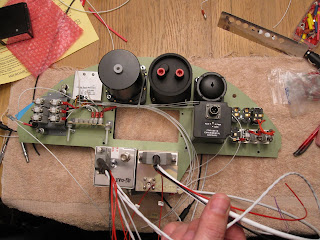
From the beginning we considered using Grove "bolt-on" axles so that toe and camber could easily be adjusted. Hawkeye has explained the rational for this mod in some of his previous postings. In the end, we decided to take a shot at using the straight tubular steel axles per Pete's plans knowing that we could always cut off the unwanted portion of the axle and add a flange for the bolt-on type axle.
In spite of our best efforts, we wound up with a few degrees of dreaded toe-in on both my and Glenn Bridges Skyoties. Glenn reports that his is a handful on pavement so it looks like a fix is in order. We had originally planned to just weld on the new flange after cutting off the old axle. Robbie Grove of Grove cautioned that the flange needs to be nice and flat to provide a good seat for the bolt on axle. With this in mind, we decided to use a bolt on flange adaptor. This allows the face of the adaptor flange to be machined flat after welding. The CAD rendering above shows how it all comes together.
The brake torque plate will bolt on the outboard face of the Grove axle flange so the Skyote landing gear track will increase a little.
The Grove axles are "in the mail" so I will post some pictures of the actual components soon.




 s.
s.





























